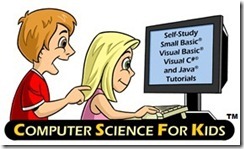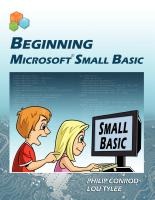“Code a little, test a little.” This is the mantra of the Microsoft  Small Basic course from Computer Science for Kids. Producing quality computer programming tutorials for over 25 years, Computer Science for Kids has brought computer programming to a very user-friendly format. The Microsoft Small Basic course is recommended for kids ages 10+ and is currently available at a special discounted price of $34.95 through July 4, 2013. After that, the price will go up to the original $59.95 cost. We received the Instant Internet "Download Only" Digital E-Book Edition Single User License to use and explore for purpose of review.
Small Basic course from Computer Science for Kids. Producing quality computer programming tutorials for over 25 years, Computer Science for Kids has brought computer programming to a very user-friendly format. The Microsoft Small Basic course is recommended for kids ages 10+ and is currently available at a special discounted price of $34.95 through July 4, 2013. After that, the price will go up to the original $59.95 cost. We received the Instant Internet "Download Only" Digital E-Book Edition Single User License to use and explore for purpose of review.
I will admit that I am getting old. I actually remember the first time my family got more than 3 tv channels, when we got our first VCR, and the first time I worked on a computer. All of things happened when I was in my second year of college. My kids don’t understand the concept of computers that don’t run with windows or internet. My first experience with a computer, in college, was taking the required introductory computer programming course. Being a 19 year old, and taking this class at 8 am, meant I missed a lot of classes. Consequently, I struggled greatly. Everything we did in the class had to do with binary numbers and coding information that I didn’t understand. Fast forward to the present and you will understand the trepidation with which I met this Microsoft Small Basic course. I have to say, I have been pleasantly surprised.
Microsoft Small Basic is a computer programming course; but, it is more like a guided road map through computer programming. Once the program is loaded on your computer you have access to both the program and the e-book that takes you through step-by-step. I have been printing out one chapter at a time for my kids and I to work through. I do have the ability to snap pages on my computer, so, if one kid is reading through the lesson for the day, another can have the lesson opened in one window on the computer while working in another. We have been spending around an hour – an hour and a half a day working on computer programming. The first two chapters of the curriculum didn’t take us as long to go through. Most of the information in these chapters has to do with introductory material, setting up the program, and some basics of programming. Once we moved into chapter 3, the real fun began!
Chapter 3 took us through the steps to create our first basic program, a ‘Sub-Sandwich Party.’ We learned that programming can be a two steps forward, one step back experience. This is where the ‘code a little, test a little’ mantra begins to show its worth. In programming, just as in entering usernames and passwords into existing programs, things can be case sensitive and location sensitive. Everything, even spaces, can change how or if your program functions. We just completed chapter 4 where we learned how to program basic mathematical functions and creating a savings calculator. This chapter made a little more sense to me because I am very mathematical. The kids have been enjoying it because they like being able to tell the computer how to ‘do math’ for them. I think they must believe they are creating their own calculator.  They do take these lessons slowly, because there is so much great information to digest. I definitely recommend a print copy of the e-book because you will want to take notes and underline and highlight as you work. My kids make notes of things that did not work and highlight strings of code that they have to input.
They do take these lessons slowly, because there is so much great information to digest. I definitely recommend a print copy of the e-book because you will want to take notes and underline and highlight as you work. My kids make notes of things that did not work and highlight strings of code that they have to input. 
As we move into chapter 5 and beyond, we will be working on debugging programs, creating loops, sub-routines, and even mouse functions. Chapter 11 is the final chapter and introduces the user to more complex programming. We are looking forward to continuing to use Microsoft Small Basic for the rest of this school year and over the summer. For my high school age kids, this course is going to be listed as Computer Programming on their transcripts. Until now, I just had them go through basic keyboarding skills. This takes their computer knowledge to an entirely new level. I recommend Microsoft Small Basic for anyone, pre-teen through adult, who wants to learn about how computer programs are put together and how to create basic computer programs. It is easy to follow, although, as with most computer things, there is a learning curve. You will learn terminology and skills that are incredibly useful in our computerized world.
To read what my friends on the Schoolhouse Review Crew have to say about Microsoft Small Basic, as well as another program by Computer Science for Kids, click on the banner below.




No comments:
Post a Comment